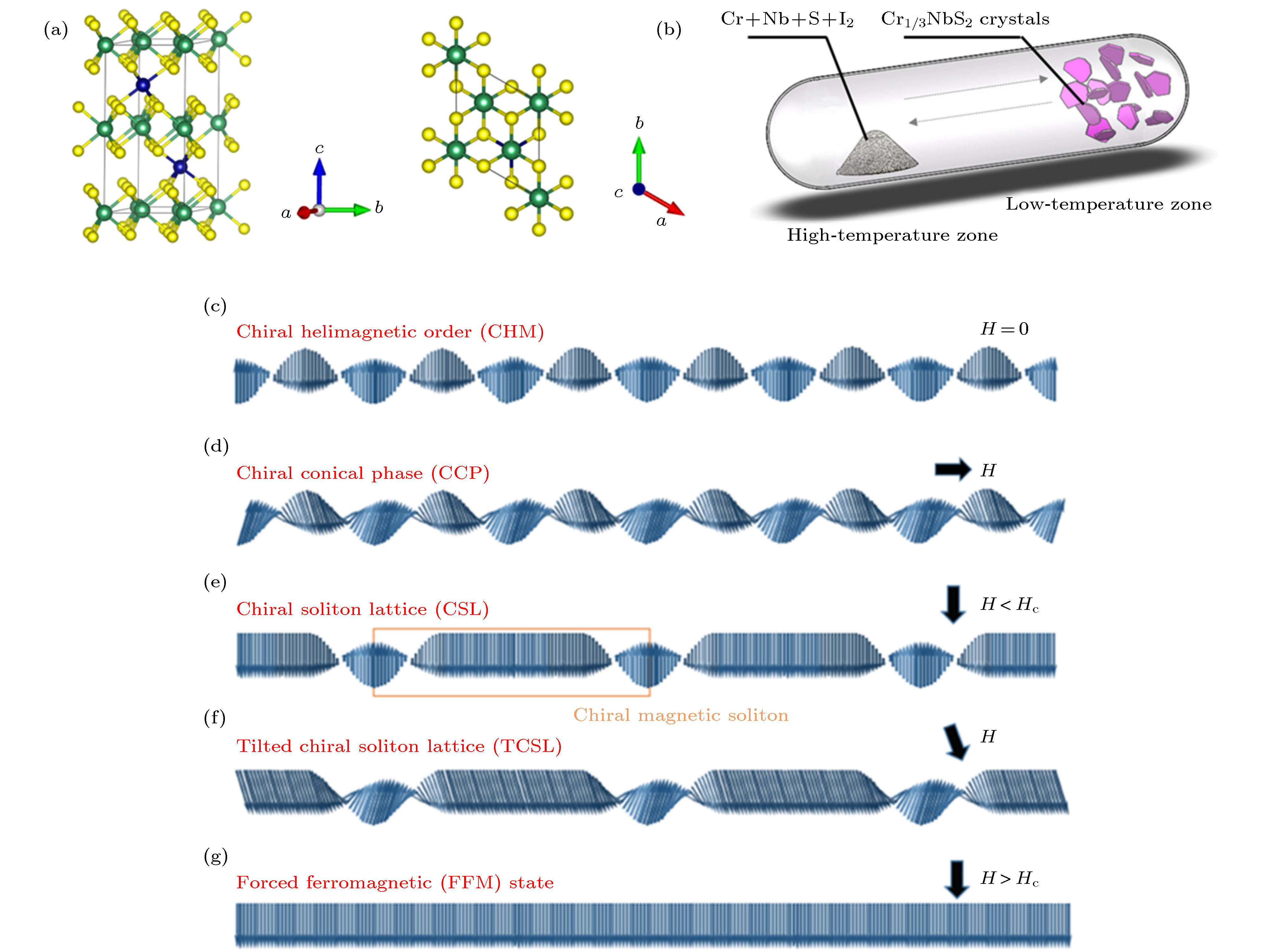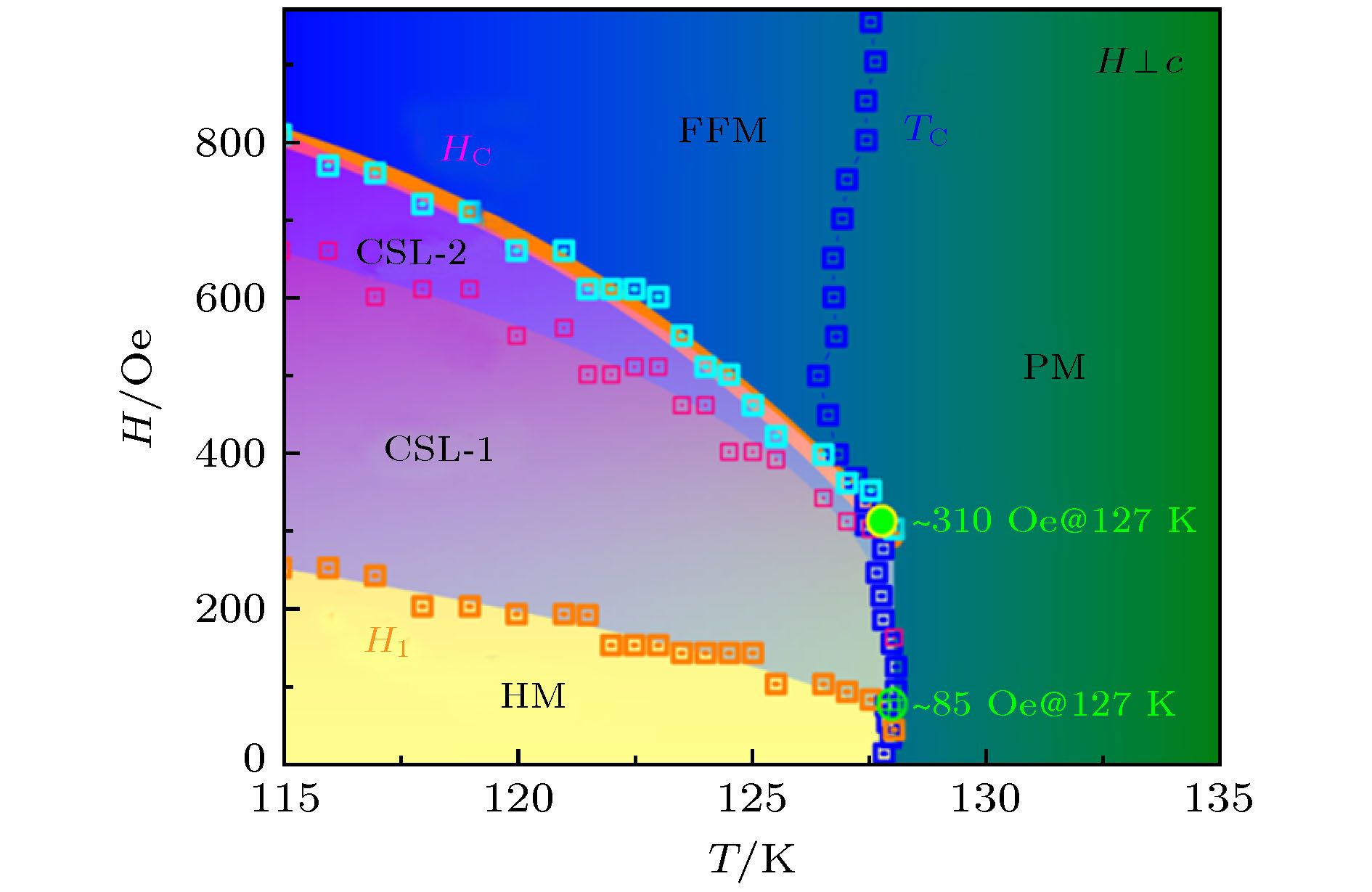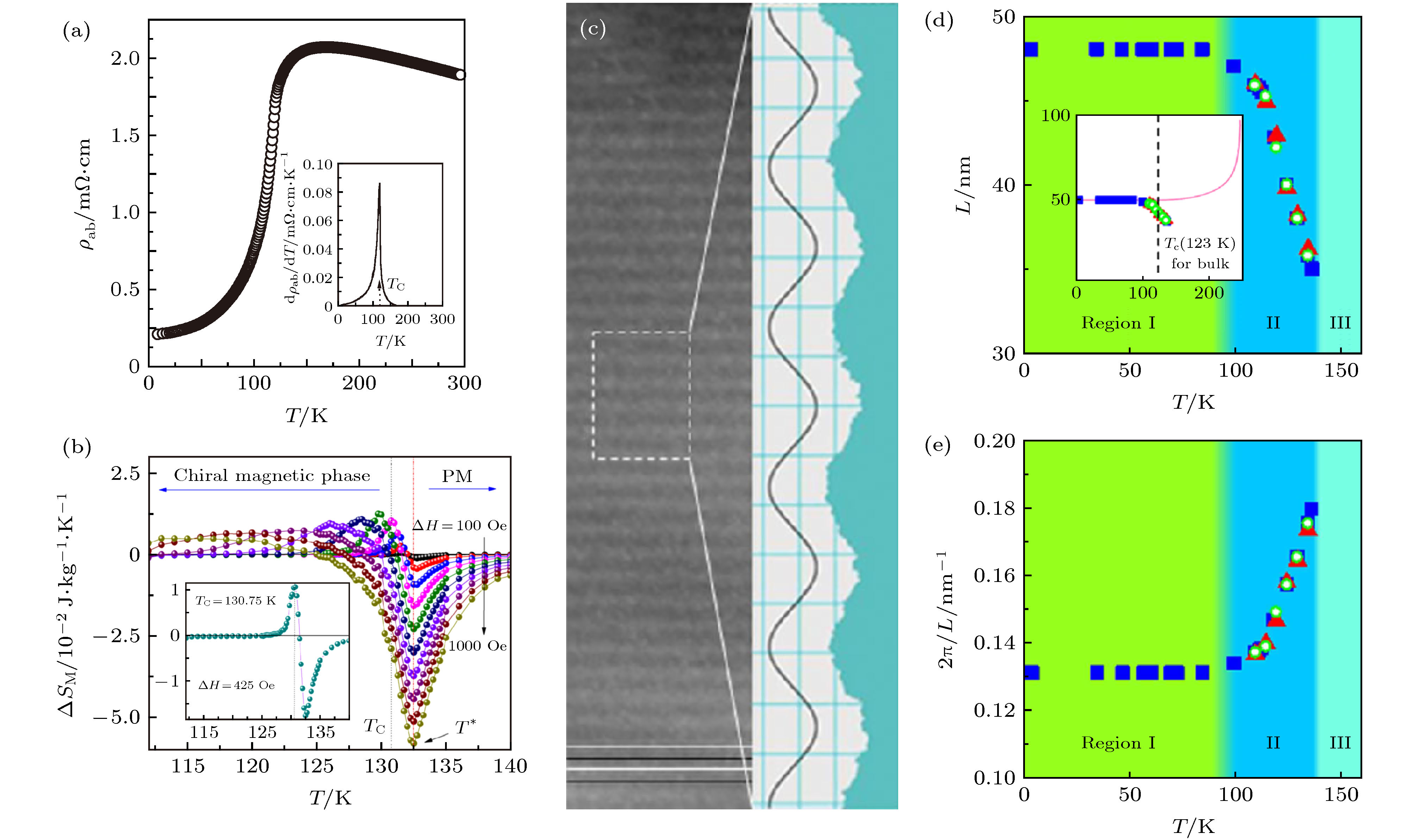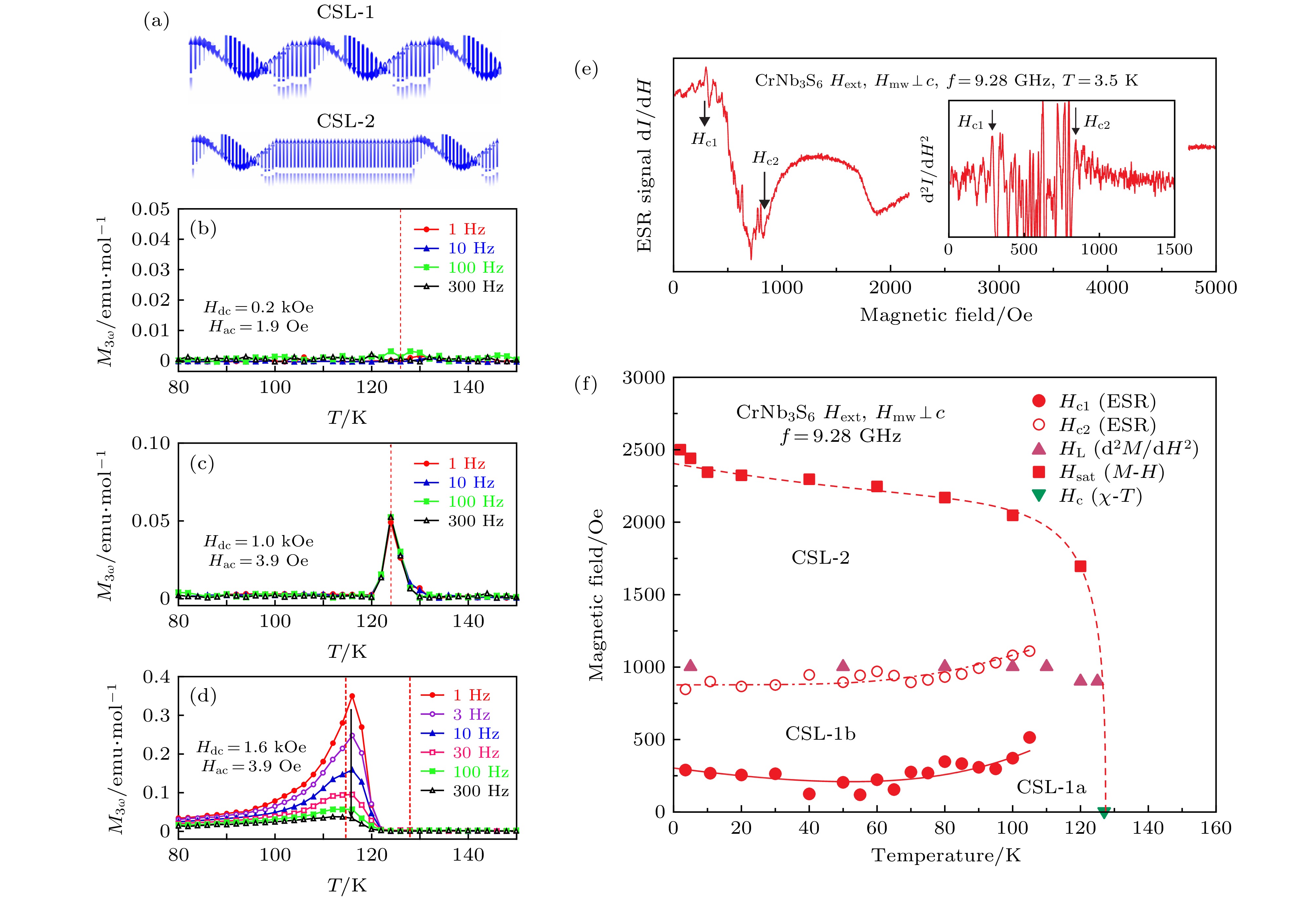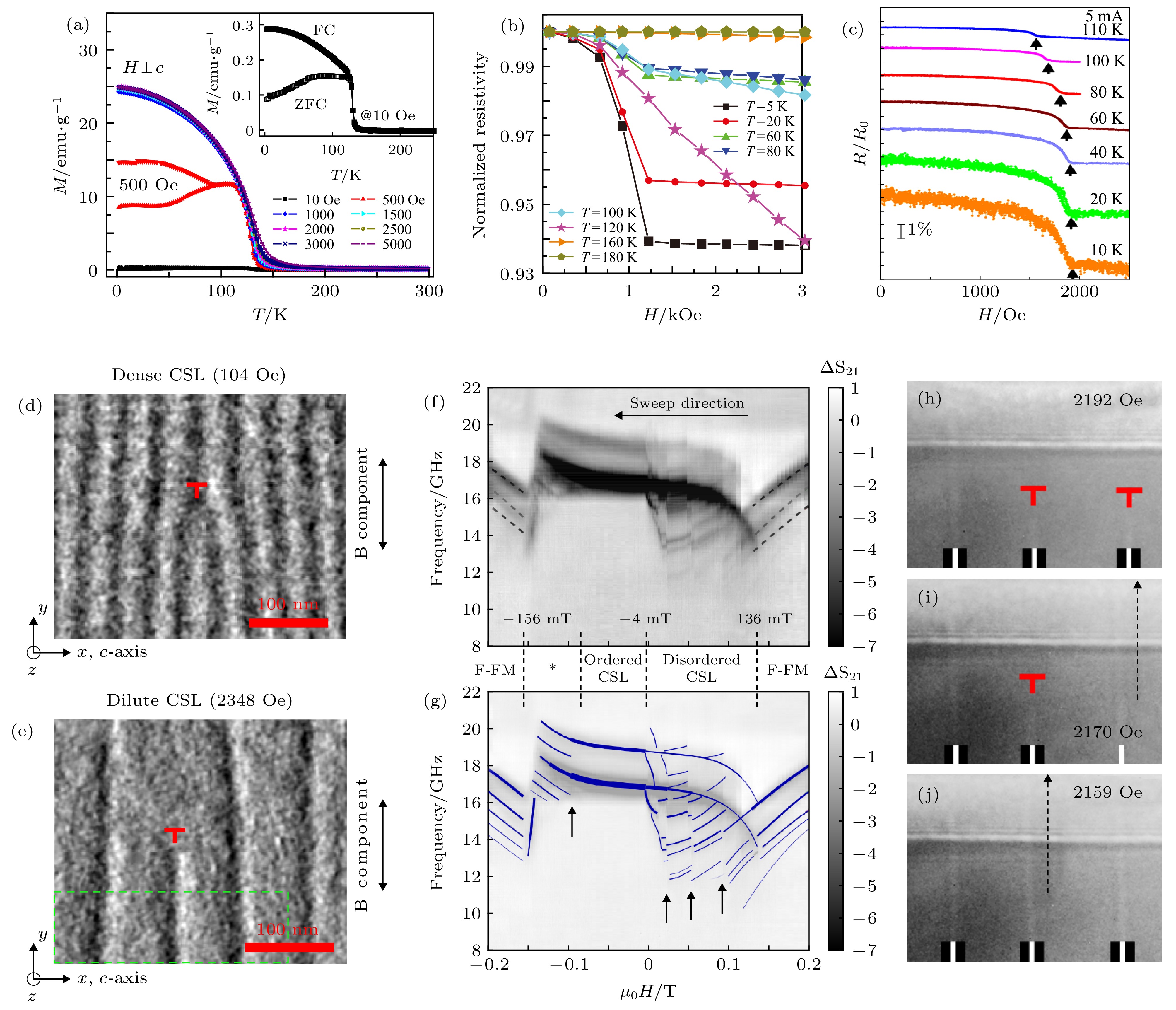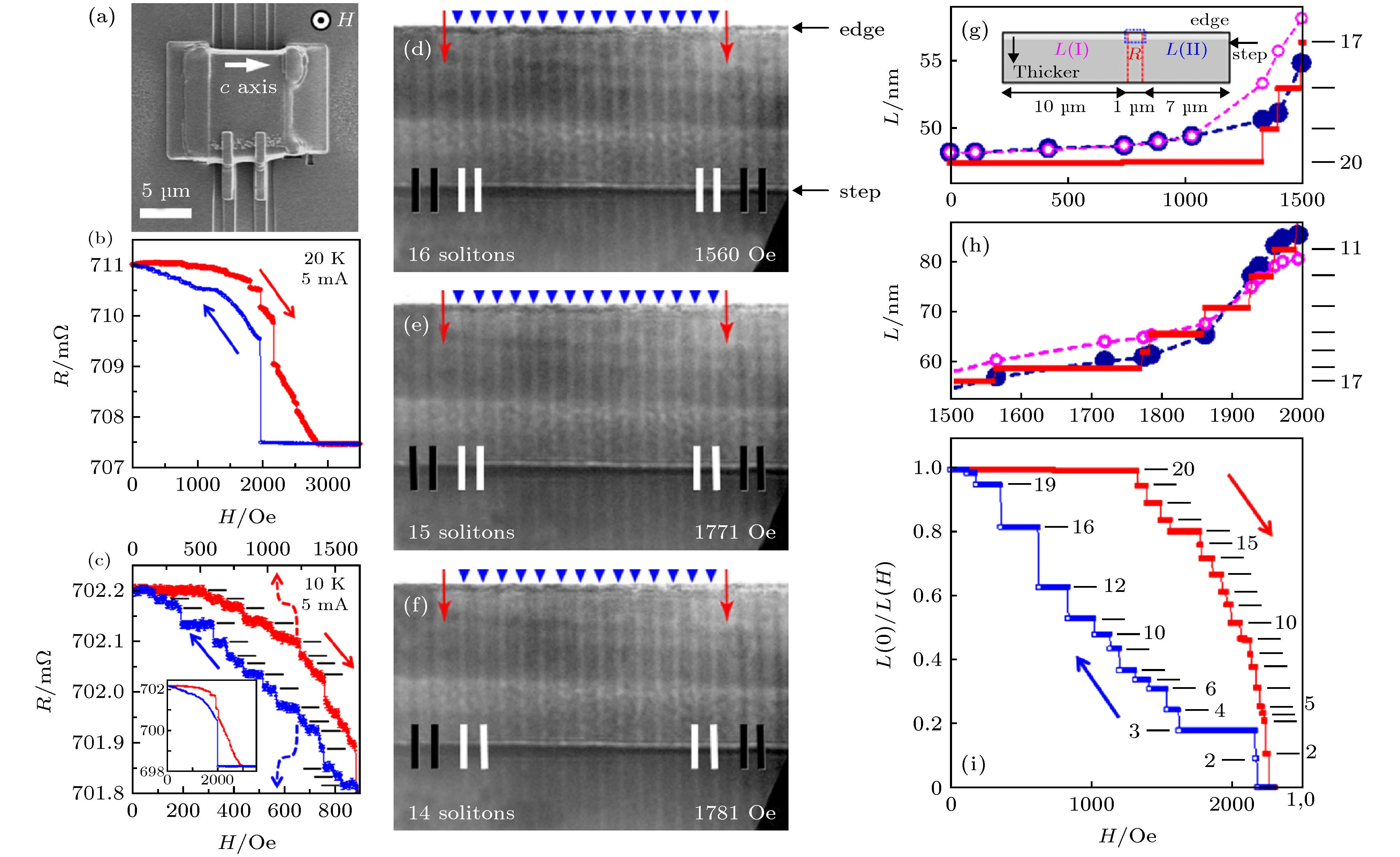-
伴随着拓扑材料的出现, 拓扑物理学成为了当代凝聚态物理的前沿与热点之一. 拓扑特性是描述材料的物理量在连续变换下会保持不变的性质(如陈数Chern number), 种类包括拓扑绝缘体、外尔和狄拉克等拓扑半金属、拓扑磁材料等. 一维手性磁孤子(chiral magnetic solitons), 类似于磁性斯格明子(skyrmions), 是一类具有拓扑性和准粒子性的磁结构, 具有丰富的物理特性和潜在应用价值. 本文详细总结了一种具有一维手性磁孤子结构的晶体Cr1/3NbS2, 包括其晶体构型、磁相互作用、磁结构、维度调控以及相变物理等物理特性. 希望本综述能为研究拓扑磁材料的科研人员提供详实的参考, 为将拓扑和手性磁性引入到二维层状材料家族提供研究思路, 促进拓扑磁电子学的发展, 为相关器件提供更多的材料选择和理论基础.With the discovery and development of topological materials, topological physics has attracted enormous research interest in the fields of contemporary condensed matter physics. Topological property, which describes such a property that physical quantity remains invariant under continuous transformation (such as Chern number), has been revealed in a variety of materials, including topological insulators, topological semimetals (such as Weyl or Dirac semimetals), topological magnetic materials, etc. One-dimensional chiral magnetic soliton, similar to magnetic skyrmion, is a type of magnetic configuration with topological origin and quasi-particle property, which has shown tremendous physical properties and device functionalities. In this review, we mainly focus on a chiral helimagnet, called Cr1/3NbS2, which possesses chiral magnetic soliton lattice and other more spin configurations under different conditions. We systematically summarize the work on Cr1/3NbS2, discussing its crystal symmetry, band structure, magnetic interactions, rich magnetic phases, and the physics of associated phase transitions. In particular, the layered crystal structure of Cr1/3NbS2 enables us to control the soliton number through tuning the layer number or crystal thickness. Our review provides a comprehensive summary of Cr1/3NbS2 in order to draw more attention to this interesting material. Moreover, we envision that our work could offer useful guidance to the researchers working on topological and chiral magnetic materials, and thus introducing topological or chiral magnetism into two-dimensional layered materials and promoting the development of modern magnetism and spintronics. Therefore, this review mainly focuses on a magnet, called Cr1/3NbS2. We systematically summarize the work on Cr1/3NbS2, discussing its crystal symmetry, band structure, magnetic interaction, rich magnetic phases and the interesting physical phenomena occurring at each phase transition. In addition, the layered crystal structure of Cr1/3NbS2 also enables us to use the layer number or crystal thickness to modulate and control its rich magnetic phases. We believe that our review provides a comprehensive summary of Cr1/3NbS2, which can make people have a better understanding of a typical topological magnetic material, thereby enriching the material types of magnets and low-dimensional material family and promoting the development of magnetism and spintronics applications, such as in magnetic memory devices, spintronic devices, and quantum information devices.
-
Keywords:
- topological magnetism /
- chiral magnetic soliton /
- layered material /
- spintronics
[1] Zhang X C, Zhou Y, Song K M, Park T E, Xia J, Ezawa M, Liu X X, Zhao W S, Zhao G P, Woo S 2020 J. Phys. Condens. Matter 32 143001
 Google Scholar
Google Scholar
[2] Skyrme T H R 1962 Nucl. Phys. 31 556
 Google Scholar
Google Scholar
[3] Bogdanov A, Hubert A 1994 J. Magn. Magn. Mater. 138 255
 Google Scholar
Google Scholar
[4] Bocdanov A, Hubert A 1994 Phys. Status Solidi B 186 527
 Google Scholar
Google Scholar
[5] Sondhi S L, Karlhede A, Kivelson S A, Rezayi E H 1993 Phys. Rev. B 47 16419
 Google Scholar
Google Scholar
[6] Yang K, Moon K, Zheng L, MacDonald A H, Girvin S M, Yoshioka D, Zhang S C 1994 Phys. Rev. Lett. 72 732
 Google Scholar
Google Scholar
[7] Rossler U K, Bogdanov A N, Pfleiderer C 2006 Nature 442 797
 Google Scholar
Google Scholar
[8] Neubauer A, Pfleiderer C, Binz B, Rosch A, Ritz R, Niklowitz P G, Boni P 2009 Phys. Rev. Lett. 102 186602
 Google Scholar
Google Scholar
[9] Jonietz F, Muhlbauer S, Pfleiderer C, Neubauer A, Munzer W, Bauer A, Adams T, Georgii R, Boni P, Duine R A, Everschor K, Garst M, Rosch A 2010 Science 330 1648
 Google Scholar
Google Scholar
[10] Yu X Z, Onose Y, Kanazawa N, Park J H, Han J H, Matsui Y, Nagaosa N, Tokura Y 2010 Nature 465 901
 Google Scholar
Google Scholar
[11] Braun H B 2012 Adv. Phys. 61 1
 Google Scholar
Google Scholar
[12] Togawa Y, Koyama T, Takayanagi K, Mori S, Kousaka Y, Akimitsu J, Nishihara S, Inoue K, Ovchinnikov A S, Kishine J 2012 Phys. Rev. Lett. 108 107202
 Google Scholar
Google Scholar
[13] Togawa Y, Kousaka Y, Inoue K, Kishine J 2016 J. Phys. Soc. Jpn. 85 112001
 Google Scholar
Google Scholar
[14] Wang L, Chepiga N, Ki D K, Li L, Li F, Zhu W, Kato Y, Ovchinnikova O S, Mila F, Martin I, Mandrus D, Morpurgo A F 2017 Phys. Rev. Lett. 118 257203
 Google Scholar
Google Scholar
[15] Han H, Zhang L, Sapkota D, Hao N N, Ling L S, Du H F, Pi L, Zhang C J, Mandrus D G, Zhang Y H 2017 Phys. Rev. B 96 094439
 Google Scholar
Google Scholar
[16] Miyadai T, Kikuchi K, Kondo H, Sakka S, Arai M, Ishikawa Y 1983 J. Phys. Soc. Jpn. 52 1394
 Google Scholar
Google Scholar
[17] Volkova L M, Marinin D V 2014 J. Appl. Phys. 116 133901
 Google Scholar
Google Scholar
[18] Dyadkin V, Mushenok F, Bosak A, Menzel D, Grigoriev S, Pattison P, Chernyshov D 2015 Phys. Rev. B 91 184205
 Google Scholar
Google Scholar
[19] Dzyaloshinsky I 1958 J. Phys. Chem. Solids 4 241
 Google Scholar
Google Scholar
[20] Moriya T 1960 Phys. Rev. 120 91
 Google Scholar
Google Scholar
[21] Shinozaki M, Hoshino S, Masaki Y, Kishine J, Kato Y 2016 J. Phys. Soc. Jpn. 85 074710
 Google Scholar
Google Scholar
[22] Kousaka Y, Nakao Y, Kishine J, Akita M, Inoue K, Akimitsu J 2009 Nucl. Instrum. Methods Phys. Res., Sect. A 600 250
 Google Scholar
Google Scholar
[23] Kishine J, Bostrem I G, Ovchinnikov A S, Sinitsyn V E 2012 Phys. Rev. B 86 214426
 Google Scholar
Google Scholar
[24] Heisenberg W 1926 Z. Phys. 38 411
 Google Scholar
Google Scholar
[25] Gong C, Zhang X 2019 Science 363 eaav4450
 Google Scholar
Google Scholar
[26] Dirac P A M 1926 Proc. R. Soc. A 112 661
 Google Scholar
Google Scholar
[27] Soumyanarayanan A, Reyren N, Fert A, Panagopoulos C 2016 Nature 539 509
 Google Scholar
Google Scholar
[28] Wiesendanger R 2016 Nat. Rev. Mater. 1 16044
 Google Scholar
Google Scholar
[29] Kishine J, Inoue K, Kikuchi K 2007 J. Magn. Magn. Mater. 310 1386
 Google Scholar
Google Scholar
[30] Aczel A A, DeBeer-Schmitt L M, Williams T J, McGuire M A, Ghimire N J, Li L, Mandrus D 2018 Appl. Phys. Lett. 113 032404
 Google Scholar
Google Scholar
[31] Bruno P 1989 Phys. Rev. B 39 865
 Google Scholar
Google Scholar
[32] Bruno P 1991 MRS Online Proc. Libr. 231 299
[33] Ghimire N J, McGuire M A, Parker D S, Sipos B, Tang S, Yan J Q, Sales B C, Mandrus D 2013 Phys. Rev. B 87 104403
 Google Scholar
Google Scholar
[34] Braam D, Gomez C, Tezok S, de Mello E V L, Li L, Mandrus D, Kee H Y, Sonier J E 2015 Phys. Rev. B 91 144407
 Google Scholar
Google Scholar
[35] Camley R E, Tilley D R 1988 Phys. Rev. B 37 3413
 Google Scholar
Google Scholar
[36] Kubetzka A, Pietzsch O, Bode M, Wiesendanger R 2003 Phys. Rev. B 67 020401(R)
 Google Scholar
Google Scholar
[37] Tanaka M, Saitoh E, Miyajima H, Yamaoka T, Iye Y 2006 Phys. Rev. B 73 052411
 Google Scholar
Google Scholar
[38] Yonemura J, Shimamoto Y, Kida T, Yoshizawa D, Kousaka Y, Nishihara S, Goncalves F J T, Akimitsu J, Inoue K, Hagiwara M, Togawa Y 2017 Phys. Rev. B 96 184423
 Google Scholar
Google Scholar
[39] Masaki Y, Stamps R L 2017 Phys. Rev. B 95 024418
 Google Scholar
Google Scholar
[40] Tsuruta K, Mito M, Kousaka Y, Akimitsu J, Kishine J, Togawa Y, Inoue K 2016 J. Appl. Phys. 120 143901
 Google Scholar
Google Scholar
[41] Tsuruta K, Mito M, Kousaka Y, Akimitsu J, Kishine J, Togawa Y, Ohsumi H, Inoue K 2016 J. Phys. Soc. Jpn. 85 013707
 Google Scholar
Google Scholar
[42] Tsuruta K, Mito M, Deguchi H, Kishine J, Kousaka Y, Akimitsu J, Inoue K 2016 Phys. Rev. B 93 104402
 Google Scholar
Google Scholar
[43] Paterson G W, Koyama T, Shinozaki M, Masaki Y, Goncalves F J T, Shimamoto Y, Sogo T, Nord M, Kousaka Y, Kato Y, McVitie S, Togawa Y 2019 Phys. Rev. B 99 224429
 Google Scholar
Google Scholar
[44] Clements E M, Das R, Li L, Lampen-Kelley P J, Phan M H, Keppens V, Mandrus D, Srikanth H 2017 Sci. Rep. 7 6545
 Google Scholar
Google Scholar
[45] Togawa Y, Kishine J, Nosov P A, Koyama T, Paterson G W, McVitie S, Kousaka Y, Akimitsu J, Ogata M, Ovchinnikov A S 2019 Phys. Rev. Lett. 122 017204
 Google Scholar
Google Scholar
[46] Grundy P J, Tebble R S 1968 Adv. Phys. 17 153
 Google Scholar
Google Scholar
[47] Ngo D T, Kuhn L T 2016 Adv. Nat. Sci.: Nanosci. Nanotechnol. 7 045001
 Google Scholar
Google Scholar
[48] Peng L C, Zhang Y, Zuo S L He M, Cai J W, Wang S G, Wei H X, Li J Q, Zhao T Y, Shen B G 2018 Chin. Phys. B 27 066802
 Google Scholar
Google Scholar
[49] Pollard S D, Garlow J A, Yu J W, Wang Z, Zhu Y M, Yang H 2017 Nat. Commun. 8 14761
 Google Scholar
Google Scholar
[50] de Réotier P D, Yaouanc A 1997 J. Phys. Condens. Matter 9 9113
 Google Scholar
Google Scholar
[51] Blundell S J 1999 Contemp. Phys. 40 175
 Google Scholar
Google Scholar
[52] Morenzoni E, Prokscha T, Suter A, Luetkens H, Khasanov R 2004 J. Phys.: Condens. Matter 16 S4583
 Google Scholar
Google Scholar
[53] Yoshizawa D, Sawada Y, Kousaka Y, Kishine J, Togawa Y, Mito M, Inoue K, Akimitsu J, Nakano T, Nozue Y, Hagiwara M 2019 Phys. Rev. B 100 104413
 Google Scholar
Google Scholar
[54] Baumann S, Paul W, Choi T, Lutz C P, Ardavan A, Heinrich A J 2015 Science 350 417
 Google Scholar
Google Scholar
[55] Yoshizawa D, Kishine J, Kousaka Y, Togawa Y, Mito M, Akimitsu J, Inoue K, Hagiwara M 2015 Physics Procedia 75 926
 Google Scholar
Google Scholar
[56] Moriya T, Miyadai T 1982 Solid State Commun. 42 209
 Google Scholar
Google Scholar
[57] Togawa Y, Kousaka Y, Nishihara S, Inoue K, Akimitsu J, Ovchinnikov A S, Kishine J 2013 Phys. Rev. Lett. 111 197204
 Google Scholar
Google Scholar
[58] Mushenok F B 2013 Phys. Solid State 55 2482
 Google Scholar
Google Scholar
[59] Mushenok F B 2013 Eur. Phys. J. B 86 342
 Google Scholar
Google Scholar
[60] Bornstein A C, Chapman B J, Ghimire N J, Mandrus D G, Parker D S, Lee M 2015 Phys. Rev. B 91 184401
 Google Scholar
Google Scholar
[61] Hall E H 1879 Am. J. Sci. 19 200
 Google Scholar
Google Scholar
[62] Nagaosa N, Sinova J, Onoda S, MacDonald A H, Ong N P 2010 Rev. Mod. Phys. 82 1539
 Google Scholar
Google Scholar
[63] Aoki R, Kousaka Y, Togawa Y 2019 Phys. Rev. Lett. 122 057206
 Google Scholar
Google Scholar
[64] Yokouchi T, Kanazawa N, Kikkawa A, Morikawa D, Shibata K, Arima T, Taguchi Y, Kagawa F, Tokura Y 2017 Nat. Commun. 8 866
 Google Scholar
Google Scholar
[65] Pop F, Auban-Senzier P, Canadell E, Rikken G L J A, Avarvari N 2014 Nat. Commun. 5 3757
 Google Scholar
Google Scholar
[66] Ideue T, Hamamoto K, Koshikawa S, Ezawa M, Shimizu S, Kaneko Y, Tokura Y, Nagaosa N, Iwasa Y 2017 Nat. Phys. 13 578
 Google Scholar
Google Scholar
[67] Qin F, Shi W, Ideue T, Yoshida M, Zak A, Tenne R, Kikitsu T, Inoue D, Hashizume D, Iwasa Y 2017 Nat. Commun. 8 14465
 Google Scholar
Google Scholar
[68] Kishine J, Bostrem I G, Ovchinnikov A S, Sinitsyn V E 2014 Phys. Rev. B 89 014419
 Google Scholar
Google Scholar
[69] Togawa Y, Koyama T, Nishimori Y, Matsumoto Y, McVitie S, McGrouther D, Stamps R L, Kousaka Y, Akimitsu J, Nishihara S, Inoue K, Bostrem I G, Sinitsyn V E, Ovchinnikov A S, Kishine J 2015 Phys. Rev. B 92 220412
 Google Scholar
Google Scholar
[70] Yu X Z, Kanazawa N, Onose Y, Kimoto K, Zhang W Z, Ishiwata S, Matsui Y, Tokura Y 2011 Nat. Mater. 10 106
 Google Scholar
Google Scholar
[71] Fert A, Cros V, Sampaio J 2013 Nat. Nanotechnol. 8 152
 Google Scholar
Google Scholar
[72] Tomasello R, Martinez E, Zivieri R, Torres L, Carpentieri M, Finocchio G 2014 Sci. Rep. 4 6784
 Google Scholar
Google Scholar
[73] Zhang X C, Zhao G P, Fangohr H, Liu J P, Xia W X, Xia J, Morvan F J 2015 Sci. Rep. 5 7643
 Google Scholar
Google Scholar
[74] Karna S K, Womack F N, Chapai R, Young D P, Marshall M, Xie W W, Graf D, Wu Y, Cao H B, DeBeer-Schmitt L, Adams P W, Jin R, DiTusa J F 2019 Phys. Rev. B 100 184413
 Google Scholar
Google Scholar
[75] Parkin S S P, Friend R H 1980 Physica B & C 99 219
 Google Scholar
Google Scholar
[76] Friend R H, Beal A R, Yoffe A D 1977 Philos. Mag. 35 1269
 Google Scholar
Google Scholar
[77] Dijkstra J, Zijlema P J, Vanbruggen C F, Haas C, Degroot R A 1989 J. Phys. Condens. Matter 1 6363
 Google Scholar
Google Scholar
[78] Gubkin A F, Proskurina E P, Kousaka Y, Sherokalova E M, Selezneva N V, Miao P, Lee S, Zhang J, Ishikawa Y, Torii S, Kamiyama T, Campo J, Akimitsu J, Baranov N V 2016 J. Appl. Phys. 119 013903
 Google Scholar
Google Scholar
[79] Zhang H W, Wei W S, Zheng G L, Lu J W, Wu M, Zhu X D, Tang J, Ning W, Han Y Y, Ling L S, Yang J Y, Gao W S, Qin Y L, Tian M L 2018 Appl. Phys. Lett. 113 072402
 Google Scholar
Google Scholar
[80] Hu W Z, Wang G T, Hu R W, Petrovic C, Morosan E, Cava R J, Fang Z, Wang N L 2008 Phys. Rev. B 78 085120
 Google Scholar
Google Scholar
[81] Novoselov K S, Jiang D, Schedin F, Booth T J, Khotkevich V V, Morozov S V, Geim A K 2005 Proc. Natl. Acad. Sci. U. S. A. 102 10451
 Google Scholar
Google Scholar
[82] Wang Q H, Kalantar-Zadeh K, Kis A, Coleman J N, Strano M S 2012 Nat. Nanotechnol. 7 699
 Google Scholar
Google Scholar
[83] Xu M S, Liang T, Shi M M, Chen H Z 2013 Chem. Rev. 113 3766
 Google Scholar
Google Scholar
[84] Novoselov K S, Geim A K, Morozov S V, Jiang D, Zhang Y, Dubonos S V, Grigorieva I V, Firsov A A 2004 Science 306 666
 Google Scholar
Google Scholar
-
图 1 磁性材料中一维、二维及三维拓扑自旋织构示意图[1,13] (a) 奈尔型(Néel-type)斯格明子(w = –1); (b) 布洛赫型(Bloch-type)斯格明子(w = –1); (c) 反斯格明子(antiskyrmion)(w = +1); (d) 双斯格明子(biskyrmion)(w = –2); (e) 涡旋态(vortex)斯格明子(w = –0.5); (f) 半子(meron)(w = –0.5); (g) 双半子(bimerom)(w = –1); (h) 套嵌斯格明子(skyrmionium)(w = 0); (i) 斯格明子管(skyrmion tube); (j) 磁浮子(magnetic bobber). 箭头表示自旋方向, 面外自旋分量(mz)分别用三种颜色表示: 红色表示朝向面外, 白色表示在面上, 蓝色表示朝向面内; (k) 左旋螺旋磁相及磁孤子晶格示意图; (l) 右旋螺旋磁相及磁孤子晶格示意图, © (2016) The Physical Society of Japan; (m), (n)对Cr1/3NbS2施加沿着垂直于c轴的外加磁场, 当磁场强度较弱时, 螺旋手性周期变长, 磁孤子数目保持不变
Fig. 1. Illustrations of a series of 1D, 2D and 3D topological spin textures in magnetic materials[1,13]: (a) Néel-type skyrmion (w = –1); (b) Bloch-type skyrmion (w = –1); (c) antiskyrmion (w = +1); (d) biskyrmion (w = –2); (e) vortex (w = –0.5); (f) meron (w = –0.5); (g) bimeron (w = –1); (h) skyrmionium (w = 0); (i) skyrmion tube, and (j) magnetic bobber. The arrow represents the spin direction and the out-of-plane spin component (mz) is represented by the color: Red is out of the plane, white is in-plane, and blue is into the plane; (k) left-handed helimagnetic structures and soliton lattices; (l) right-handed helimagnetic structures and soliton lattices © (2016) The Physical Society of Japan; (m), (n) illustrations of soliton lattices under a small magnetic field perpendicular to c-axis: the solitons number remains unchanged, while the chiral period becomes longer.
图 2 (a) Cr1/3NbS2晶体结构示意图, Cr, Nb和S原子分别由蓝色、绿色和黄色球体表示; (b) Cr1/3NbS2单晶生长方法的示意图[22]; (c)—(g) Cr1/3NbS2中不同磁相的示意图: (c) 手性螺旋磁序(CHM), 黄框标示了一个完整的磁孤子周期; (d) 手性圆锥相(CCP); (e) 手性孤子晶格(CSL); (f) 倾斜手性孤子晶格(CSL); (g) 铁磁态(FFM)
Fig. 2. (a) Crystal structure of Cr1/3NbS2, Cr, Nb and S atoms are denoted by blue, green and yellow spheres, respectively; (b) schematic illustration of Cr1/3NbS2 single crystal growth[22]; (c)–(g) schematic diagrams illustrating different spin configurations of Cr1/3NbS2: (c) Chiral helimagnetic order (CHM), in which the yellow box denotes a complete period of a chiral soliton; (d) chiral conical phase (CCP); (e) chiral soliton lattice (CSL); (f) tilted chiral soliton lattice (TCSL); (g) forced ferromagnetic (FFM) state.
图 4 (a) Cr1/3NbS2沿ab面电阻率随温度的变化关系, 内插图显示了电阻率关于温度的导数[33]; (b) ΔH = 100—1000 Oe时, 熵变随温度的变化关系(ΔSM(T)), 居里温度TC与手性有序无序转变温度T *存在温差, 内插图为TC附近的ΔSM(T )图[44]; (c) T = 110 K, 无外加磁场时的CHM的洛伦兹TEM图像, 虚线矩形区域对应的对比度强度线轮廓图中, 垂直网格间距约为15 nm, 周期约为46 nm[12]; CHM周期 (d) 和波数 (e) 随温度的变化关系. 蓝色方格表示洛伦兹菲涅耳法和DPC法获得的数据, 绿圆形和红三角形分别对应于随温度增加和减小的SAES数据, (d) 中的内插图为三维平均场理论数据和实验数据[45]
Fig. 4. (a) Temperature dependence of resistivity of Cr1/3NbS2. The inset shows the temperature deriative of resistivity[33]; (b) ΔSM-T curves for ΔH = 100–1000 Oe, a temperature gap exists between TC and order-disorder temperature T *. The inset is the ΔSM-T curves near the TC[44]; (c) the Lorentz TEM micrographs of CHM in Cr1/3NbS2 at 0 T and 110 K, with a line profile of the contrast intensity integrated in a dotted square region. Vertical grid spacing corresponds to 15 nm. The period is estimated to be 46 nm[12]; temperature dependent period (d) and wave number (e) of CHM are divided into three regions. Blue squares represent the data obtained by the Lorentz Fresnel and DPC methods. Green circle and red triangles represent the SAES data with increasing and decreasing T, respectively. The inset in (d) shows the 3D mean-field theory and the measurement data[45].
图 5 (a) 无外加磁场时, CHM的过聚焦洛伦兹TEM图像[12]; (b), (c) H⊥c时, H = 0.208 T (b) 和H = 0.224 T (c) 的CHM-CSL过聚焦洛伦兹TEM图像[12]; (d) 是 (c) 中的对比度强度线轮廓图[12]; (e) [L(H)-L(0)]/L(0)的实验数据与理论计算结果[12]; (f) L(0)/L(H)的实验数据与理论计算结果[12]; (g) 手性磁结构决定CSL洛伦兹TEM图像对比度的原理示意图[12]; (h) T = 2 K, H⊥c时的磁化曲线图[33]; (i) T = 2 K, H⊥c时的面内磁电阻随磁场的变化关系, 上内插图为磁电阻斜率随磁场的变化关系, 下内插图为电阻率关于磁场的导数[33]; (j) 总信号幅值A0随温度的变化关系[34]; (k) 不同磁场强度下μ介子自旋进动频率f随温度的变化关系[34]
Fig. 5. (a)−(c)The underfocused Lorentz micrographs in 0 T (a), magnetic fields are 0.208 T (b) and 0.224 T (c) which are perpendicular to the c-axis[12]; (d) line profile of the contrast intensity integrated in the dotted area in (c) [12]; (e) the measurement data and theoretical calculation results of [L(H)-L(0)]/L(0)[12]; (f) experimental results and theoretical calculation results of L(0)/L(H)[12]; (g) magnetic chirality determines the characteristic magnetic patterns in Lorentz micrographs of CSL[12]; (h) M-H curves of vertical magnetic field at 2 K[33]; (i) magnetoresistance with a vertical magnetic field at 2 K, The upper inset is the variation in the slope of the magnetoresistance, and the lower inset is the derivative of the resistivity with respect to the magnetic field[33]; (j) temperature dependent total intensity of A0[34]; (k) temperature dependent the muon spin precession frequency f under different magnetic field[34].
图 6 (a) CSL-1与CSL-2的结构示意图[42]; (b)—(d)交流磁响应随温度的变化关系, 在Hac = 3.9 Oe和Hdc = 0.2 kOe (e), Hdc = 1.0 kOe (f) 和 Hdc = 1.6 kOe (g) 下的M3ω, 交流磁场的频率范围为1—300 Hz[42]; (e) T = 3.5 K, H⊥c时的ESR信号, Hc1和Hc2分别表示ESR尖峰异常信号开始出现和消失时的磁场强度[53]; (f) Cr1/3NbS2的磁场与温度的相图, 实心红圈和空心红圈分别表示Hc1和Hc2[53]
Fig. 6. (a) Schematics of CSL-1 and CSL-2[42]; (b)–(d) temperature dependence of the AC magnetic response M3ω under Hac = 3.9 Oe and Hdc = 0.2 kOe (b), Hdc = 1.0 kOe (c) and Hdc = 1.6 kOe (d). The frequency of all the AC magnetic field in the range of 1 to 300 Hz[42]; (e) ESR signal at T = 3.5 K for H⊥c. The Hc1 and Hc2 indicate the appearing and disappearing fields of the anomalous signal[53]; (f) H-T phase diagram of Cr1/3NbS2, The red solid and open circles indicate the Hc1 and Hc2, respectively[53].
图 7 (a) H⊥c时, Cr1/3NbS2在不同磁场强度下对应的M(T)图, 内插图显示了10 Oe对应的零场冷(zero-field-cooling, ZFC)和场冷(field-cooling, FC)曲线[15]; (b) H⊥c时, 不同温度下的归一化面内电阻率随磁场的变化关系[33]; (c) T = 10—110 K时, 电流I = 5 mA的归一化层间磁电阻随磁场的变化关系[57]; (d), (e) T = 102 K且H⊥c时, 磁结构位错(红色“⊥”符号旋转)的DPC-STEM图像, 磁场大小分别为104 Oe (d) 与2348 Oe (e)[43]; (f) T = 50 K, 在50 μm长的手性轴上以1 mT的步长所测量样品的铁磁共振谱图[43]; (g) 是 (f) 的简化图, 用“*”标记的区域具有混合特性[43]; (h)—(j) 在薄片样品中垂直运动的孤子的洛伦兹TEM图像, 显示了在FFM到CSL相变过程中, 随着施加磁场的减小, 孤子位错(旋转的红色“⊥”符号)进行的单向引导运动[43]
Fig. 7. (a) M-T curves under different fields for Cr1/3NbS2 with H⊥c, the inset shows the zero-field-cooling (ZFC) and field-cooling (FC) curves under 10 Oe with H⊥c; (b) the relationship between normalized resistivity and magnetic field with H⊥c at various temperatures[33]; (c) the normalized interlayer magnetoresistance (MR) curves which is applied 5 mA in a temperature range from 10 to 110 K[57]; (d)–(e) DPC-STEM images of dislocations (rotated red “⊥” symbols) at low (left column, 104 Oe) and high (right column, 2348 Oe) fields at 102 K in presence of a magnetic field perpendicular to c axis[43]; (f) ferromagnetic resonance measurements on a sample with a 50-μm-long chiral axis at 50 K in the range of + 0.2 to – 0.2 T with 1 mT steps, showing the effect of magnetic properties with magnetic phase transitions[43]; (g) a simplified sketch of (f), the field region has mixed characteristics which marked as “*” [43]; (h)–(j) the Lorentz Fresnel images of solitons running vertically in a flake sample, showing the unidirectional guided movement of soliton dislocations (rotated red “⊥” symbols) as the applied (h)–(j) magnetic field decreases during the FFM to CSL phase transition[43].
图 8 (a) 上图为T = 5 K时, 不同角度下平行于磁场的磁化强度分量M∥与磁场强度H关系, 内插图为器件测试结构, 下图表示相应磁场下测得的面内磁电阻, 垂直线表示不同角度磁场下的极化磁场
$ H_{\rm{P}}^{{\theta _{\rm{H}}}}$ [60]; (b) 霍尔效应示意图; (c) 反常霍尔效应示意图; (d) H∥c时, 不同温度下霍尔电阻率ρyx随磁场的变化关系[60]; (e)由ρyx决定的正常霍尔系数(RH)和反常霍尔系数(SH)随温度的变化关系[60]; (f) T = 2—120 K时, 去除正常霍尔效应贡献的电阻率随磁场的变化关系[60]; (g) 电磁手性效应(EMC)原理图; (h) 在不同温度下REMC随磁场的变化关系[63]Fig. 8. (a) The upper diagram shows the magnetization component (M∥) parallel to magnetic fields as a function of H with different angles at 5 K. The inset is the measuring configuration. The lower diagram shows the in-plane magnetoresistance measured under corresponding magnetic fields. Vertical lines indicate the polarization field
$H_{\rm{P}}^{{\theta _{\rm{H}}}}$ with different direction[60]; (b)–(c) scheme of Hall effect (b), anomalous Hall effect (c); (d) the relationship between magnetic field and ρxy at various temperature with H∥c[60]; (e) the relationship between ordinary Hall coefficient (RH), anomalous Hall coefficient (SH) and temperature, which are determined from ρyx[60]; (f) the relationship between magnetic field and ρyx besides ordinary Hall effect measured at temperature in the range of 2 to 120 K[60]; (g) scheme of the electrical magnetochiral (EMC) effect; (h) magnetic field dependent REMC measured under a large range of temperature[63].图 9 (a) Cr1/3NbS2晶体所制成器件的扫描离子显微照片[69]; T = 20 K (b) 和T = 10 K (c) 时的磁电阻随磁场的变化关系, 内插图为(c)中高磁场区域磁电阻随磁场的变化关系[69]; (d)—(f) T = 100 K, CSL的洛伦兹TEM图像, 分别处在1560 (d), 1771 (e)和1781 Oe (f) 的磁场下, 红色箭头表示手性边界, 蓝色箭头表示右手手性磁孤子[69]; (g), (h) 手性磁孤子结构的周期长度随磁场的变化关系, 内插图为样品尺寸示意图[69]; (i)手性磁孤子数目随磁场变化关系, 初始局域磁孤子数目为20[69]
Fig. 9. (a) Scanning ion micrograph of the device based on Cr1/3NbS2 crystals, the size of the flake is
$10\;{\rm{ \text{μ} m}} \times 10 \;{\rm{\text{μ} m}} \times 1 \;{\rm{\text{μ} m}}$ [69]; (b), (c) the MR curves at 20 (b) and 10 K (c), the inset is the MR curves under a higher magnetic field in (c) [69]; (d)–(f) Lorentz Fresnel images of CSL taken under the underfocused condition around the crystal grain of right-handed chirality at 1560 (d), 1771 (e) and 1781 Oe (f) at 100 K. Red arrows represent chiral boundary and blue arrows represent right-handed chiral boundary [69]; (g), (h) the relationship between soliton period and magnetic field. The inset shows the sample dimensions[69]; (i) it shows the corresponding soliton density, The initial number of confined solitons is 20[69].图 10 (a) 不同厚度Cr1/3NbS2晶体的光学显微照片[14]; (b) T = 250 mK时, 不同厚度Cr1/3NbS2晶体的磁电阻随磁场的变化关系[14]; (c)—(e) 无外加磁场下的Cr原子的自旋x分量 (Sx) 随样品厚度的变化关系, 通过理论计算厚度分别为1.5L0 (c), 2.5L0 (d), 5.5L0 (e) 时的情况, 其中L0 = 48 nm为无外加磁场下磁孤子周期长度[14]; (f) t = 2.5L0时, 不同磁场下最低能量分布关系[14]; (g), (h)反映了不同磁场下对应出现的单个磁孤子 (g) 和无磁孤子 (h)最低能量构型[14]
Fig. 10. (a) Optical microscope images of Cr1/3NbS2 crystals with various thickness[14]; (b) the magnetoresistance of Cr1/3NbS2 with different thicknesses measured at 250 mK[14]; (c)–(e) the relationship between the x component of spins on the Cr atoms (Sx) and the thickness at zero magnetic field. Calculating results using the model to with t = 1.5L0 (c), 2.5L0 (d), and 5.5L0 (e) (L0 = 48 nm) [14]; (f) the lowest energy distribution under different magnetic fields when t = 2.5 L0[14]; (g) and (h) show the corresponding lowest energy configurations for single and zero soliton states, respectively[14].
-
[1] Zhang X C, Zhou Y, Song K M, Park T E, Xia J, Ezawa M, Liu X X, Zhao W S, Zhao G P, Woo S 2020 J. Phys. Condens. Matter 32 143001
 Google Scholar
Google Scholar
[2] Skyrme T H R 1962 Nucl. Phys. 31 556
 Google Scholar
Google Scholar
[3] Bogdanov A, Hubert A 1994 J. Magn. Magn. Mater. 138 255
 Google Scholar
Google Scholar
[4] Bocdanov A, Hubert A 1994 Phys. Status Solidi B 186 527
 Google Scholar
Google Scholar
[5] Sondhi S L, Karlhede A, Kivelson S A, Rezayi E H 1993 Phys. Rev. B 47 16419
 Google Scholar
Google Scholar
[6] Yang K, Moon K, Zheng L, MacDonald A H, Girvin S M, Yoshioka D, Zhang S C 1994 Phys. Rev. Lett. 72 732
 Google Scholar
Google Scholar
[7] Rossler U K, Bogdanov A N, Pfleiderer C 2006 Nature 442 797
 Google Scholar
Google Scholar
[8] Neubauer A, Pfleiderer C, Binz B, Rosch A, Ritz R, Niklowitz P G, Boni P 2009 Phys. Rev. Lett. 102 186602
 Google Scholar
Google Scholar
[9] Jonietz F, Muhlbauer S, Pfleiderer C, Neubauer A, Munzer W, Bauer A, Adams T, Georgii R, Boni P, Duine R A, Everschor K, Garst M, Rosch A 2010 Science 330 1648
 Google Scholar
Google Scholar
[10] Yu X Z, Onose Y, Kanazawa N, Park J H, Han J H, Matsui Y, Nagaosa N, Tokura Y 2010 Nature 465 901
 Google Scholar
Google Scholar
[11] Braun H B 2012 Adv. Phys. 61 1
 Google Scholar
Google Scholar
[12] Togawa Y, Koyama T, Takayanagi K, Mori S, Kousaka Y, Akimitsu J, Nishihara S, Inoue K, Ovchinnikov A S, Kishine J 2012 Phys. Rev. Lett. 108 107202
 Google Scholar
Google Scholar
[13] Togawa Y, Kousaka Y, Inoue K, Kishine J 2016 J. Phys. Soc. Jpn. 85 112001
 Google Scholar
Google Scholar
[14] Wang L, Chepiga N, Ki D K, Li L, Li F, Zhu W, Kato Y, Ovchinnikova O S, Mila F, Martin I, Mandrus D, Morpurgo A F 2017 Phys. Rev. Lett. 118 257203
 Google Scholar
Google Scholar
[15] Han H, Zhang L, Sapkota D, Hao N N, Ling L S, Du H F, Pi L, Zhang C J, Mandrus D G, Zhang Y H 2017 Phys. Rev. B 96 094439
 Google Scholar
Google Scholar
[16] Miyadai T, Kikuchi K, Kondo H, Sakka S, Arai M, Ishikawa Y 1983 J. Phys. Soc. Jpn. 52 1394
 Google Scholar
Google Scholar
[17] Volkova L M, Marinin D V 2014 J. Appl. Phys. 116 133901
 Google Scholar
Google Scholar
[18] Dyadkin V, Mushenok F, Bosak A, Menzel D, Grigoriev S, Pattison P, Chernyshov D 2015 Phys. Rev. B 91 184205
 Google Scholar
Google Scholar
[19] Dzyaloshinsky I 1958 J. Phys. Chem. Solids 4 241
 Google Scholar
Google Scholar
[20] Moriya T 1960 Phys. Rev. 120 91
 Google Scholar
Google Scholar
[21] Shinozaki M, Hoshino S, Masaki Y, Kishine J, Kato Y 2016 J. Phys. Soc. Jpn. 85 074710
 Google Scholar
Google Scholar
[22] Kousaka Y, Nakao Y, Kishine J, Akita M, Inoue K, Akimitsu J 2009 Nucl. Instrum. Methods Phys. Res., Sect. A 600 250
 Google Scholar
Google Scholar
[23] Kishine J, Bostrem I G, Ovchinnikov A S, Sinitsyn V E 2012 Phys. Rev. B 86 214426
 Google Scholar
Google Scholar
[24] Heisenberg W 1926 Z. Phys. 38 411
 Google Scholar
Google Scholar
[25] Gong C, Zhang X 2019 Science 363 eaav4450
 Google Scholar
Google Scholar
[26] Dirac P A M 1926 Proc. R. Soc. A 112 661
 Google Scholar
Google Scholar
[27] Soumyanarayanan A, Reyren N, Fert A, Panagopoulos C 2016 Nature 539 509
 Google Scholar
Google Scholar
[28] Wiesendanger R 2016 Nat. Rev. Mater. 1 16044
 Google Scholar
Google Scholar
[29] Kishine J, Inoue K, Kikuchi K 2007 J. Magn. Magn. Mater. 310 1386
 Google Scholar
Google Scholar
[30] Aczel A A, DeBeer-Schmitt L M, Williams T J, McGuire M A, Ghimire N J, Li L, Mandrus D 2018 Appl. Phys. Lett. 113 032404
 Google Scholar
Google Scholar
[31] Bruno P 1989 Phys. Rev. B 39 865
 Google Scholar
Google Scholar
[32] Bruno P 1991 MRS Online Proc. Libr. 231 299
[33] Ghimire N J, McGuire M A, Parker D S, Sipos B, Tang S, Yan J Q, Sales B C, Mandrus D 2013 Phys. Rev. B 87 104403
 Google Scholar
Google Scholar
[34] Braam D, Gomez C, Tezok S, de Mello E V L, Li L, Mandrus D, Kee H Y, Sonier J E 2015 Phys. Rev. B 91 144407
 Google Scholar
Google Scholar
[35] Camley R E, Tilley D R 1988 Phys. Rev. B 37 3413
 Google Scholar
Google Scholar
[36] Kubetzka A, Pietzsch O, Bode M, Wiesendanger R 2003 Phys. Rev. B 67 020401(R)
 Google Scholar
Google Scholar
[37] Tanaka M, Saitoh E, Miyajima H, Yamaoka T, Iye Y 2006 Phys. Rev. B 73 052411
 Google Scholar
Google Scholar
[38] Yonemura J, Shimamoto Y, Kida T, Yoshizawa D, Kousaka Y, Nishihara S, Goncalves F J T, Akimitsu J, Inoue K, Hagiwara M, Togawa Y 2017 Phys. Rev. B 96 184423
 Google Scholar
Google Scholar
[39] Masaki Y, Stamps R L 2017 Phys. Rev. B 95 024418
 Google Scholar
Google Scholar
[40] Tsuruta K, Mito M, Kousaka Y, Akimitsu J, Kishine J, Togawa Y, Inoue K 2016 J. Appl. Phys. 120 143901
 Google Scholar
Google Scholar
[41] Tsuruta K, Mito M, Kousaka Y, Akimitsu J, Kishine J, Togawa Y, Ohsumi H, Inoue K 2016 J. Phys. Soc. Jpn. 85 013707
 Google Scholar
Google Scholar
[42] Tsuruta K, Mito M, Deguchi H, Kishine J, Kousaka Y, Akimitsu J, Inoue K 2016 Phys. Rev. B 93 104402
 Google Scholar
Google Scholar
[43] Paterson G W, Koyama T, Shinozaki M, Masaki Y, Goncalves F J T, Shimamoto Y, Sogo T, Nord M, Kousaka Y, Kato Y, McVitie S, Togawa Y 2019 Phys. Rev. B 99 224429
 Google Scholar
Google Scholar
[44] Clements E M, Das R, Li L, Lampen-Kelley P J, Phan M H, Keppens V, Mandrus D, Srikanth H 2017 Sci. Rep. 7 6545
 Google Scholar
Google Scholar
[45] Togawa Y, Kishine J, Nosov P A, Koyama T, Paterson G W, McVitie S, Kousaka Y, Akimitsu J, Ogata M, Ovchinnikov A S 2019 Phys. Rev. Lett. 122 017204
 Google Scholar
Google Scholar
[46] Grundy P J, Tebble R S 1968 Adv. Phys. 17 153
 Google Scholar
Google Scholar
[47] Ngo D T, Kuhn L T 2016 Adv. Nat. Sci.: Nanosci. Nanotechnol. 7 045001
 Google Scholar
Google Scholar
[48] Peng L C, Zhang Y, Zuo S L He M, Cai J W, Wang S G, Wei H X, Li J Q, Zhao T Y, Shen B G 2018 Chin. Phys. B 27 066802
 Google Scholar
Google Scholar
[49] Pollard S D, Garlow J A, Yu J W, Wang Z, Zhu Y M, Yang H 2017 Nat. Commun. 8 14761
 Google Scholar
Google Scholar
[50] de Réotier P D, Yaouanc A 1997 J. Phys. Condens. Matter 9 9113
 Google Scholar
Google Scholar
[51] Blundell S J 1999 Contemp. Phys. 40 175
 Google Scholar
Google Scholar
[52] Morenzoni E, Prokscha T, Suter A, Luetkens H, Khasanov R 2004 J. Phys.: Condens. Matter 16 S4583
 Google Scholar
Google Scholar
[53] Yoshizawa D, Sawada Y, Kousaka Y, Kishine J, Togawa Y, Mito M, Inoue K, Akimitsu J, Nakano T, Nozue Y, Hagiwara M 2019 Phys. Rev. B 100 104413
 Google Scholar
Google Scholar
[54] Baumann S, Paul W, Choi T, Lutz C P, Ardavan A, Heinrich A J 2015 Science 350 417
 Google Scholar
Google Scholar
[55] Yoshizawa D, Kishine J, Kousaka Y, Togawa Y, Mito M, Akimitsu J, Inoue K, Hagiwara M 2015 Physics Procedia 75 926
 Google Scholar
Google Scholar
[56] Moriya T, Miyadai T 1982 Solid State Commun. 42 209
 Google Scholar
Google Scholar
[57] Togawa Y, Kousaka Y, Nishihara S, Inoue K, Akimitsu J, Ovchinnikov A S, Kishine J 2013 Phys. Rev. Lett. 111 197204
 Google Scholar
Google Scholar
[58] Mushenok F B 2013 Phys. Solid State 55 2482
 Google Scholar
Google Scholar
[59] Mushenok F B 2013 Eur. Phys. J. B 86 342
 Google Scholar
Google Scholar
[60] Bornstein A C, Chapman B J, Ghimire N J, Mandrus D G, Parker D S, Lee M 2015 Phys. Rev. B 91 184401
 Google Scholar
Google Scholar
[61] Hall E H 1879 Am. J. Sci. 19 200
 Google Scholar
Google Scholar
[62] Nagaosa N, Sinova J, Onoda S, MacDonald A H, Ong N P 2010 Rev. Mod. Phys. 82 1539
 Google Scholar
Google Scholar
[63] Aoki R, Kousaka Y, Togawa Y 2019 Phys. Rev. Lett. 122 057206
 Google Scholar
Google Scholar
[64] Yokouchi T, Kanazawa N, Kikkawa A, Morikawa D, Shibata K, Arima T, Taguchi Y, Kagawa F, Tokura Y 2017 Nat. Commun. 8 866
 Google Scholar
Google Scholar
[65] Pop F, Auban-Senzier P, Canadell E, Rikken G L J A, Avarvari N 2014 Nat. Commun. 5 3757
 Google Scholar
Google Scholar
[66] Ideue T, Hamamoto K, Koshikawa S, Ezawa M, Shimizu S, Kaneko Y, Tokura Y, Nagaosa N, Iwasa Y 2017 Nat. Phys. 13 578
 Google Scholar
Google Scholar
[67] Qin F, Shi W, Ideue T, Yoshida M, Zak A, Tenne R, Kikitsu T, Inoue D, Hashizume D, Iwasa Y 2017 Nat. Commun. 8 14465
 Google Scholar
Google Scholar
[68] Kishine J, Bostrem I G, Ovchinnikov A S, Sinitsyn V E 2014 Phys. Rev. B 89 014419
 Google Scholar
Google Scholar
[69] Togawa Y, Koyama T, Nishimori Y, Matsumoto Y, McVitie S, McGrouther D, Stamps R L, Kousaka Y, Akimitsu J, Nishihara S, Inoue K, Bostrem I G, Sinitsyn V E, Ovchinnikov A S, Kishine J 2015 Phys. Rev. B 92 220412
 Google Scholar
Google Scholar
[70] Yu X Z, Kanazawa N, Onose Y, Kimoto K, Zhang W Z, Ishiwata S, Matsui Y, Tokura Y 2011 Nat. Mater. 10 106
 Google Scholar
Google Scholar
[71] Fert A, Cros V, Sampaio J 2013 Nat. Nanotechnol. 8 152
 Google Scholar
Google Scholar
[72] Tomasello R, Martinez E, Zivieri R, Torres L, Carpentieri M, Finocchio G 2014 Sci. Rep. 4 6784
 Google Scholar
Google Scholar
[73] Zhang X C, Zhao G P, Fangohr H, Liu J P, Xia W X, Xia J, Morvan F J 2015 Sci. Rep. 5 7643
 Google Scholar
Google Scholar
[74] Karna S K, Womack F N, Chapai R, Young D P, Marshall M, Xie W W, Graf D, Wu Y, Cao H B, DeBeer-Schmitt L, Adams P W, Jin R, DiTusa J F 2019 Phys. Rev. B 100 184413
 Google Scholar
Google Scholar
[75] Parkin S S P, Friend R H 1980 Physica B & C 99 219
 Google Scholar
Google Scholar
[76] Friend R H, Beal A R, Yoffe A D 1977 Philos. Mag. 35 1269
 Google Scholar
Google Scholar
[77] Dijkstra J, Zijlema P J, Vanbruggen C F, Haas C, Degroot R A 1989 J. Phys. Condens. Matter 1 6363
 Google Scholar
Google Scholar
[78] Gubkin A F, Proskurina E P, Kousaka Y, Sherokalova E M, Selezneva N V, Miao P, Lee S, Zhang J, Ishikawa Y, Torii S, Kamiyama T, Campo J, Akimitsu J, Baranov N V 2016 J. Appl. Phys. 119 013903
 Google Scholar
Google Scholar
[79] Zhang H W, Wei W S, Zheng G L, Lu J W, Wu M, Zhu X D, Tang J, Ning W, Han Y Y, Ling L S, Yang J Y, Gao W S, Qin Y L, Tian M L 2018 Appl. Phys. Lett. 113 072402
 Google Scholar
Google Scholar
[80] Hu W Z, Wang G T, Hu R W, Petrovic C, Morosan E, Cava R J, Fang Z, Wang N L 2008 Phys. Rev. B 78 085120
 Google Scholar
Google Scholar
[81] Novoselov K S, Jiang D, Schedin F, Booth T J, Khotkevich V V, Morozov S V, Geim A K 2005 Proc. Natl. Acad. Sci. U. S. A. 102 10451
 Google Scholar
Google Scholar
[82] Wang Q H, Kalantar-Zadeh K, Kis A, Coleman J N, Strano M S 2012 Nat. Nanotechnol. 7 699
 Google Scholar
Google Scholar
[83] Xu M S, Liang T, Shi M M, Chen H Z 2013 Chem. Rev. 113 3766
 Google Scholar
Google Scholar
[84] Novoselov K S, Geim A K, Morozov S V, Jiang D, Zhang Y, Dubonos S V, Grigorieva I V, Firsov A A 2004 Science 306 666
 Google Scholar
Google Scholar
计量
- 文章访问数: 21492
- PDF下载量: 839
- 被引次数: 0













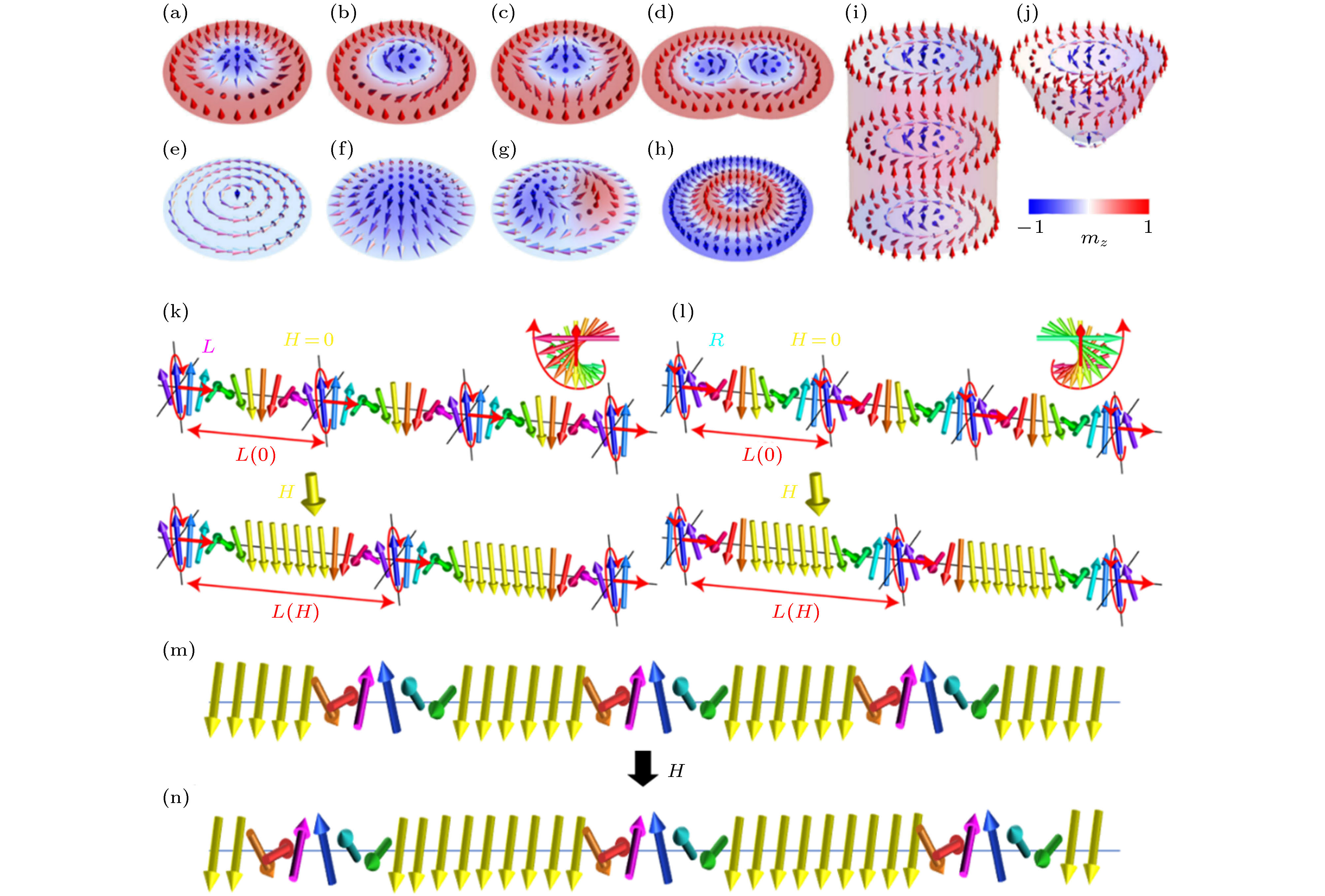
 下载:
下载:
